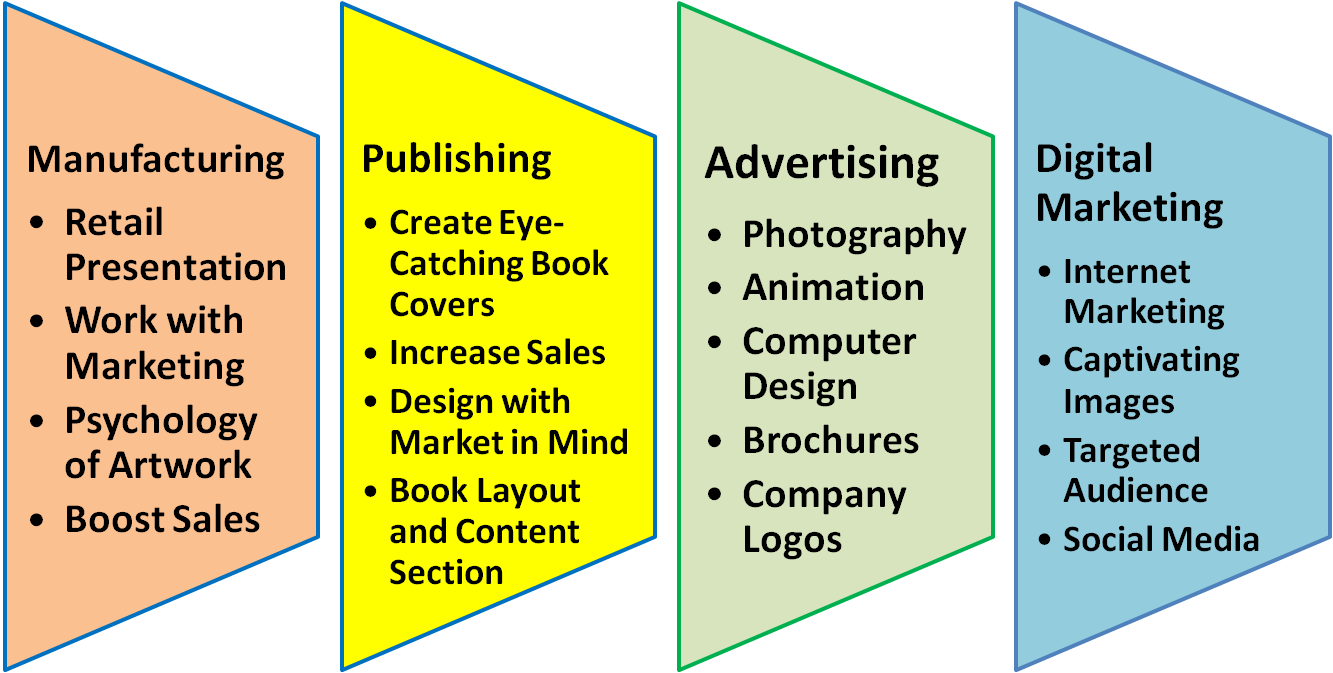In our post-What Jobs are there with a Degree in Graphic Arts?-we looked at specific occupations. In this article, we take a wide-angle view by presenting the business sectors, which employ graphic designers. From manufacturing to the arts, there are places to use your artistic talents in this discipline.
Manufacturing
There are several areas in this category where design is vital. In packaging, the artwork and colors have a purpose. These qualities should capture the attention of a buyer. Retail is one example where design is paramount. A product group where this is prevalent is cereal boxes. The images on the product should be attractive enough to stand out among the competition. Visuals can translate to sales. Therefore, designers may collaborate with marketing to create an eye-catching package.
Studies show that the redesign of a product can boost sales. Not only is the visual presentation of a label but also the wording significant. Too much information on a product’s label may deter buyers. Consumers prefer concise and straightforward labels. Therefore, the design takes into account psychology with the artwork, particularly during the launch of a new product. With the creation of a new brand, designers and marketers face the challenge of snatching sales from established items.
Publishing
Despite the proliferation of online book sources, there remains a demand for print books. Sales continue to grow, which keeps publishers busy.
Print books sold almost 700 million units in 2017 or a 1.9% rise in sales
Similar to package design, the cover of a book needs to be seductive visually. At retail, there is a lot of competition on the shelves. Publishers want their print book to generate sales. The first step is to make the cover and title enticing enough for the browser to take it off the shelf for a quick read. Many buyers glance at the front cover and read the back or inside flap for an overview.
In non-fiction, whoever designed the For Dummies cover created instant recognition. The yellow and black artwork on every book became their trademark. Consequently, the instructive tone of the material and the recognizable design has resulted in huge sales. There are over 125 million of their books in print.
Designers help authors and publishers create an emphatic cover. The font, colors, images, and symbols incorporated into the cover affect sales. Fiction tends to be more image-conscious than non-fiction when it comes to making the book attractive to browsers in a store. Non-fiction may rely on the text format and spacing on the cover. Book layout, contents section, page numbering, and spacing are also crucial for reference books.
Advertising
Graphic design is visual communication. Through photography, artwork, color, type, layout, and illustrations, advertising conveys a message. Schools offer bachelor’s programs in the dual majors of advertising and graphic design. You learn about marketing, branding, computer design, photography, animation, and psychology of advertising.
The list of application in advertising is long. Examples are billboards, company logos, signage, brochures, magazines, journals, and the internet. The job opportunities in these examples exist in advertising and design firms. Some perform freelance work or operate as a consultant.
In 2017, the United States spent $197.5 billion on advertising
Globally, spending keeps escalating. In 2014, worldwide advertising was $488.48 billion. The projection for 2020 is $722.35 billion.
Digital Marketing
Internet marketing and online advertising reached $88 billion in 2017.
The amount is a 21% increase over 2016. From small companies to Fortune 500 corporations, digital marketing continues to reach an expanding audience. The Interactive Advertising Bureau (IAB) reports that 63% of advertising is on mobile devices. The expansion in ad dollars has created the integration of graphic design with digital marketing. The two now meld together.
Online advertising requires the talent of a designer to create crisp and captivating images and messages. The massive amount of targeted consumers means designers must understand their audience. What appeals to those under 30 years old may not register with people over fifty. The designer, then, has to tailor the images and wording to which the viewer can relate.
Another application is the internet. Traffic to a site is vital to its success. The role of the designer is to produce via graphics, a website that intrigues and engages. The viewer is more apt to linger. As the view pauses, the message in the site may spur the individual to action. The images have relayed the intended impression.
The industries above are just a few of the areas where you can work with a graphic design degree. However, your degree will limit your aspirations if you lack the vivid imagination and artistry the profession demands.



